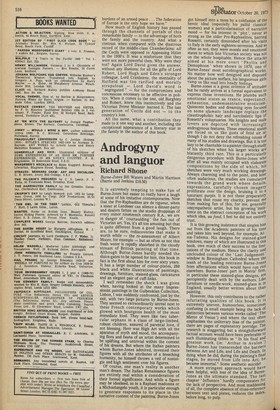Androgyny and languor
Richard Shone
Burne-Jones Bill Waters and Martin Harrison (Barrie and Jenkins E10.50)
It is extremely tempting to make fun of Burne-Jones but easier to really have a laugh at some of his imitative contemporaries. Now that the Pre-Raphaelites are de rigueur, when a sneer at Landseer can silence a dinner-party and dealers fatten on the studio droppings of every minor nineteenth century R.A., we are in danger of ' courtaulding ' the fun out of Victorian art. Yes, it's all too amusing but that is quite different from a good laugh. There are, to be sure, rediscoveries that make it worth while — the re-assessment of Albert Moore, for example — but as often as not this fresh water is rapidly absorbed in the cloudy stream of British painting of that time. Although Burne-Jones hardly needed the sluice-gates to be opened for him, this book in fact is the first about him for over sixty years. It has a large number of colour-plates, 280 black and white illustrations of paintings, drawings, furniture, stained-glass, caricatures and an elegant pair of cuff-links.
I well remember the shock I was given when, having looked at the many Impressionist paintings in the Gulbenkian Collection, Lisbon, I was suddenly confronted, just by the, exit, with two large pictures by Burne-Jones. They seemed so extraordinarily unreal next to these French contemporary works which glowed with bourgeois health of the most immediate kind. They were like two tubercular orphans in a class of large-limbed, robust children, assured of parental love, if not blessing.. Here was High Art with all the aparatus of myth and mood, the accompanying flora and fauna of an artist determined to be uplifting and untrivial within the context of his dreams. But where the Italian painters whom Burne-Jones admired, invested their figures with all the attributes of a breathing humanity, he himself throws a veil of nostalgia and high sentiment over his figures. Of course, one man's reality is another man's dream. The Italian Renaissance figures are entirely real within a consideration of their formal significance. And while a figure may be idealised, as in a Raphael madonna or a Michaelangelo youth, it is particular enough to generate responses to its place in the narrative content of the painting. Burne-Jones got himself into a mess by a confusion of the heroic ideal (especially his pallid classical women) and a particularisation of narrative mood — for his interest in ' plot ', never as strong as the older Pre-Raphaelites, barring Rossetti, certainly diminished after his visits to Italy in the early eighteen-seventies. And as often as not, they were moods and emotional states to which late Victorian society was not on the whole hospitable. Hence the attacks aimed at his more overt ' Phyllis and Demophoon ' when shown in 1870, one of Burne-Jones' most autobiographical works. No matter how well designed and disposed about the picture surface, his languorous girls vamp us like mad into heady feelings.
Burne-Jones is a great inventor of attitudes but he rarely arrives at a formal equivalent tc express these inventions. He plumbs such emotional states as trance, expectancy, exhaustion, undemonstrative eroticism. Quiescent bodies and dreaming eyes focused on some sfumato landscape replace the claustrophobic hair and narcissistic lips of Rossetti's voluptuaries. His knights and male lovers are depicted with increasingly androgynous features. These emotional states are forced on us like gusts of fetid air although I do not deny the refreshing ozone of many of his studies and drawings. But it is too lazy to be charitable to a painter through studY of his sketches when his larger works are blatantly third rate. This is a particularlY dangerous procedure with Burne-Jones who after all was mainly occupied with elaborate compositions by the side of which, his sketches were very much working drawings. Always charming and to the point, and later often audacious, the studies are cumulative towards the grand work where details, expressions, carefully chosen imagerY proliferate over the design, bruising it to a luxuriant purple. It is not these preparatorY sketches that rouse my charity, prevent me from making fun of this, for me, generallY unsympathetic artist, but his growing' insistence on the abstract conception of his work which idea, au fond, I feel he did not entirelY trust.
It is this growing insistence that singles him out from the Academic painters of his time and takes him well beyond, for example, Alma-Tadema. His designs for stained-glaSs windows, many of which are illustrated in this book, owe much of their success to the limitations of the medium. Hence the clarity and, unclouded colour of the 'Last Judgement windpw in Birmingham Cathedral where the leash of the leading restrains Burne-Jon.es from affectations which would have run pot elsewhere. Burne-Jones' part in Morris' firm, in particular these stained-glass designs, are percipiently dealt with by the authors. Like furniture or needle-work, stained-glass is 10 England, usually better written about than painting..
However, this only contributes to the rather infuriating qualities of this book. It is extremely uneven, humourless, sometimes, confusing (a small example being the lack ni distinction between various works called 'The Mirror of Venus ') and where the text often
emphasises the unliterary bias of the painter, there are pages of explanatory porridge. The
research is staggering but a straightforward
factual account would have been preferable to, such illuminating titbits as "In his final an,0
greatest work, (ie: 'Arthur in Avalon )
Burne-Jones has transcended the barriers between Art and Life, and Life and Death: In dying when he did, during the painting's final stages, he moved from Life into Art; he
became immortal." Some aesthetic suicide!
A more stringent approach would have been helpful, with less of the idea of BurneJones as the ultimate standard. The last chapter ' Influence ' hardly compensates ,for the lack of perspective. And most maddening of all, the complete absence of cross-reference between text and plates, reduces the index, before long, to pulp.


































































 Previous page
Previous page